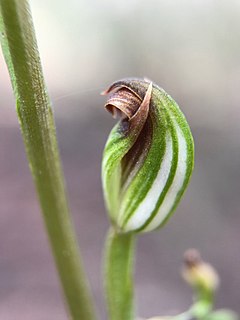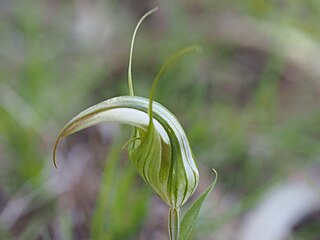
Pterostylis coccina, commonly known as the scarlet greenhood, is a species of orchid endemic to eastern Australia. As with similar greenhoods, the flowering plants differ from those which are not flowering. The non-flowering plants have a rosette of leaves flat on the ground but the flowering plants have a single flower with leaves on the flowering spike. In this species, the rosette leaves are relatively large and dark green, and the flowers are white, and bluish-green or red. It grows in New South Wales and north-eastern Victoria.

Pterostylis grandiflora, commonly known as the cobra greenhood or superb greenhood, is a species of orchid endemic to south-eastern Australia. As with similar orchids, the flowering plants differ from those which are not flowering. The non-flowering plants have a rosette of leaves but the flowering plants lack a rosette and have a single flower with leaves on the flowering spike. This greenhood has a green and white, striped flower with deep red-brown markings especially on its "galea", and a sharply pointed dorsal sepal.

Pterostylis fischii, commonly known as Fisch's greenhood, is a species of orchid endemic to south-eastern Australia. As with similar greenhoods, the flowering plants differ from those which are not flowering. The non-flowering plants have a rosette of leaves flat on the ground but the flowering plants have a single flower with leaves on the flowering spike. This greenhood has tawny-coloured flowers, a dorsal sepal with a long thread-like tip and a labellum which is hidden inside the flower.

Pterostylis atrans, commonly known as the dark-tip greenhood or blunt-tongue greenhood, is a species of orchid endemic to south-eastern Australia. As with similar greenhoods, plants in flower differ from those that are not flowering. The non-flowering plants have a rosette of leaves flat on the ground, but the plants in flower have a single flower with leaves on the flowering spike. In this species, the flower is green and reddish brown with a protruding sinus and small club-like tips on the ends of the lateral sepals.

Pterostylis revoluta, commonly known as the autumn greenhood, is a species of orchid endemic to south-eastern Australia. As with similar greenhoods, the flowering plants differ from those which are not flowering. The non-flowering plants have a rosette of leaves flat on the ground but the flowering plants have a single flower with leaves on the flowering spike. This greenhood has white and green flowers which have a long, curved, pointed labellum which extends beyond the sinus between the lateral sepals.

Pterostylis ventricosa is a recently described and critically endangered species of orchid endemic to a small area of New South Wales. As with similar orchids, the flowering plants differ from those which are not flowering. The non-flowering plants have a rosette of leaves but the flowering plants lack a rosette at the base but have up to six tiny green, white and brown flowers.

Pterostylis aneba is a species of orchid endemic to south-eastern Australia. It is a recently described and poorly-known greenhood similar to Pterostylis alpina and P. monticola. It has a rosette of fleshy leaves at the base of the plant and a single green and white flower. It grows in alpine and sub-alpine habitats.

Pterostylis rubescens, commonly known as the blushing tiny greenhood, is a species of orchid endemic to south-eastern Australia. As with similar orchids, the flowering plants differ from those which are not flowering. The non-flowering plants have a rosette of leaves but the flowering plants lack a rosette at the base and have up to eighteen tiny green, white and brownish flowers.
Pterostylis agathicola, commonly known as the kauri greenhood, is a species of orchid endemic to the North Island of New Zealand. As with similar greenhoods, the flowering plants differ from those which are not flowering. The non-flowering plants have a rosette of leaves flat on the ground but the flowering plants have a single flower with leaves on the flowering spike. It grows almost exclusively in kauri forest and has a relatively large green and transparent white flower.

Pterostylis amabilis is a species of orchid endemic to eastern Australia. As with similar orchids, the flowering plants differ from those which are not flowering. The non-flowering plants have a rosette of leaves but the flowering plants lack a rosette at the base but have up to ten tiny white and red to reddish-brown flowers. It is similar to P. parviflora but has larger rosette leaves and larger, more brightly coloured flowers.
Pterostylis atriola, commonly known as the snug greenhood, is a species of orchid endemic to Tasmania. As with similar orchids, the flowering plants differ from those which are not flowering. The non-flowering plants only have a rosette of leaves but the flowering plants have one or two rosettes on growths from the base and up to ten small, dark green, white and brown flowers on a relatively tall flowering spike. It is a rare species, only known from four widely separated populations.

Pterostylis sp. aff. alata is a species of orchid endemic to New South Wales but which has not yet been formally described. Non-flowering plants have a rosette of leaves but the flowering plants have a single flower with leaves on the flowering spike. This greenhood has a white flower with green markings and a brown-tipped dorsal sepal. It is only known from areas near Armidale where it grows near south-facing escarpments.

Pterostylis daintreana, commonly known as Daintree's greenhood, is a species of orchid endemic to eastern Australia. The non-flowering plants have a rosette of leaves on short stalks but flowering plants have up to ten flowers with rosettes on the side of the flowering spike. The flowers are translucent white with dark green lines and long, downcurved lateral sepals.
Pterostylis nigricans, commonly known as the dark greenhood, is a species of orchid endemic to eastern Australia. As with similar orchids, the flowering plants differ from those which are not flowering. The non-flowering plants have a rosette of leaves but the flowering plants lack a rosette at the base but have up to six tiny green, white and brown flowers which have a rough texture.
Pterostylis paludosa, commonly known as swamp greenhood, is a species of greenhood orchid endemic to New Zealand. As with similar orchids, plants in flower differ from those that are not. Those not in flower have a rosette of leaves on a short stalk but plants in flower lack a rosette and have a single flower with leaves on the flowering spike. This greenhood has a translucent white flower with pale to yellowish-green stripes.
Pterostylis puberula, commonly known as the dwarf greenhood or snail greenhood is a species of orchid which is endemic to New Zealand. It has a rosette of pale yellowish, stalked leaves and a single silvery-white and green flower with relatively long, erect lateral sepals.

Pterostylis reflexa, commonly known as the dainty greenhood, is a species of orchid endemic to New South Wales. As with similar greenhoods, the flowering plants differ from those which are not flowering. The non-flowering plants have a rosette of leaves flat on the ground but the flowering plants have a single flower with leaves on the flowering stem. This greenhood has a relatively large white, green and light brown flower with a long, curved dorsal sepal and a protruding labellum.
Pterostylis russellii, commonly known as Russell's greenhood, is a species of orchid endemic to eastern Australia. Non-flowering plants have a rosette of leaves flat on the ground but flowering plants have a single shiny white and dark green flower on a flowering stem lacking a rosette but with a few spreading stem leaves.
Pterostylis uliginosa, commonly known as the marsh greenhood, is a species of orchid endemic to south-eastern Australia. As with similar orchids, the flowering plants differ from those which are not flowering. The non-flowering plants have a rosette of leaves but the flowering plants lack a rosette at the base but have up to three rosettes on lateral growths and up to seven small green and white flowers. This species only grows in wet places, usually where there is free water. There are usually only two or three flowers per plant, and only one or two are open at a time.
Pterostylis divaricata is a species of orchid endemic to northern New South Wales. It grows in colonies of genetically identical plants. As with similar orchids, plants in flower differ from those that are not. Those not in flower have a rosette of leaves that lie flat on the ground. Plants in flower lack a rosette at the base but have up to ten translucent white flowers with green and brown stripes. This greenhood is similar to P. striata but has larger flowers and a longer tip on the dorsal sepal.




















